Beauty surrounds us, but usually we need to be walking in a garden to know it. ∼Rumi
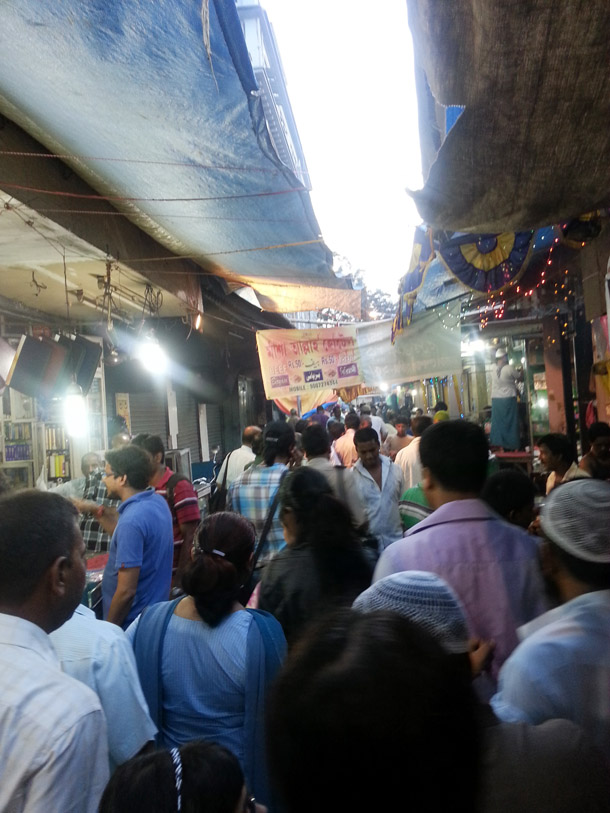
‘Why do you need to go on a food tour in Kolkata with a guide?’ My friends and family members were pretty baffled. I, who have been going around each and every lane, bylane, market, sweet shop, food kiosk, restaurant in Kolkata – with my Nikon, smartphone and the Z-Sisters in tow. Well that’s true. But Kolkata being Kolkata – the overstimulated kaleidoscope that it is, the melting pot of culture, heritage and history that it is, one needs a guide… an explorer rather, who can guide you through the exploration of the city’s chaos and decadence. Specially, if that happens to be North Kolkata. Well, I wanted to explore the city through the eyes of a tourist. I wanted to discover someone who is as passionate about the city as I am. To whom I could trust all my readers who send me incessant questions like ‘What can we do in Kolkata’? And I am so happy that I did find my *Kolkata-soul-mate* in Iftekhar Ahsan, or Explorer Ifte (as he likes to call himself), the founder of Calcutta Walks which organizes walks and food tours in the city. Walking with Ifte and hearing all the stories he narrated through out the walk – I felt, yes… this is exactly how I want my readers to experience Kolkata. 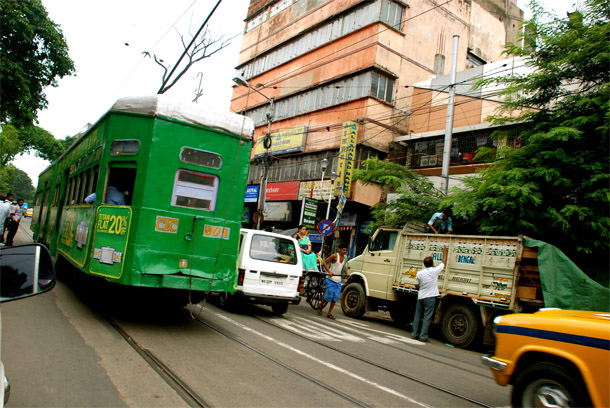
This was not a sugar coated Kolkata, a beautified city encased in five star hotels and glitzy shopping mall, but the heart and soul of a city which has lived through many ups and downs and still breathing through brazen moments, day in and day out. This walk was not for everyone, because this city was not for everyone. If one survives through the roller coaster ride, then one becomes eternally betrothed. As I have written in an earlier post, Kolkata is my city, my home. It stirs up my emotions, it stirs up my soul. The city at dusk through the heavy dark thunder clouds, the incessant noise from the crowded streets, the familiar and the unfamiliar faces, the multiple options of local savouries, the hurtling riot of colours – these rejuvenate me… My friends who have no prior experience of Kolkata, often ask me – ‘What do you like about Kolkata?’or ‘Hey, we want to visit Kolkata. What do you suggest we should see?’ – these questions make me nervous, as well as excited. Nervous, because I want them to like my Kolkata. Excited, because I have a huge things-to-do-list which I can hand over! How can I explain to them that one has feel the city, live the city and then only realise what Kolkata is. It is as good as living in a kaleidoscope.

A kaleidoscope indeed. Exploring the Nakhoda Mosque area around North Kolkata on a Friday evening during the Iftar time, is not just an ordinary experience – it is an experience of a lifetime. Long after the walk was over, the 5 hours that I spent with Ifte flashed back into my mind, sometimes in slow motion and sometimes in fast forward mode. What did I just experience? An assault on all my senses. Nudging myself through the crowded snaky lanes, sniffing through the incessant frying of Pakodas, the tunes of the Adhan or the call to prayer by the Muezzin shattering through the flight of pigeons, the rainclouds floating away giving way to the dark skies, the myriad of honking and tinkling from the trams, hand pulled rickshaws, autos, cars, vans, push carts, buses and the pedestrians – this was exactly how I had imagined the walking route to be. But what I had never imagined was the unexpected warmth of strangers that we met along our journey and the variety of stalls that we dodged ourselves through – both food and non-food. The stories and the mini cultural and historical nuggets hurled at us every now and then by Ifte… made me shudder at actually how less I knew my own city – me, who has been professing love for Kolkata to everyone – on print, on the blog, even on video!
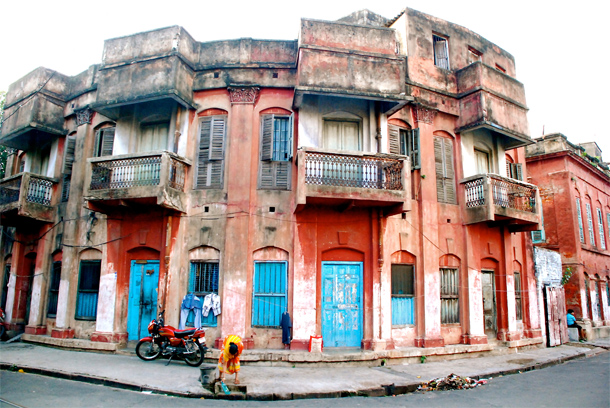
I met Ifte in front of the Air India/Indian Airlines Building on Central Avenue, close to the northern exit of Chandni Chowk Metro station and immediately hit it off. This must be the first *love triangle* story in the world where there weren’t any pangs of jealousy or envy. Both of us had the same lover – Kolkata – and we bonded over that. I chatted with him for almost 20 minutes before we were joined in by the other members who would later accompany us for the Ramadan food walk. Why and how did he start the city walk and what is the reaction of those who have gone out with him, and of course what was the plan for the evening… translated which means which are the places that we were going to eat! We were slightly off the schedule and Ifte implored that we walk a bit fast as he intended to break his Iftar around the Nakhoda Mosque area. We zigzagged through crowded lanes and zipped past dilapidated houses that were once built upon the mighty powers of the rich traders who dwelt in Kolkata. I was trying to imagine how royal this part of Kolkata must have been in it’s heydays. Although decadence has its beauty, most often they reflect stories of misfortune. And amidst all the decadence, the ones that stand out are grand testimonials to success stories – like the Laha House (G C Laha is India’s oldest paint dealer and has been serving for over 100years), the Statesman House and many others.
As we left the main Chittaranjan Avenue and slipped into the narrower Biplabi Anukul Chandra Street, Ifte started explaining to us the different sects of Muslims who had settled in the city – the Bohris, the Afghans etc. As we arrived at the Sabir’s Hotel (above) which specialised in Awadhi cusine, this was one place which had become popular with the Afghans. Ifte told us that Sabir’s served the best Rezalas in town and one of his recommendations were to try the Goat tongue and brain fry with the Rezala! Apart from traditional Bengali food, Kolkata cuisine has a lot of Muslim influence – specially the Lucknowy or the Awadhi influence. The cooking style of many of the Muslim restaurants root back to the princely Indian state of Awadh (Oudh) in the times of Nawab Mohammed Wajid Ali Shah Bahadur (1822 AD-1887 AD). In 1857 AD after the Awadh kingdom was annexed by the British, the Nawab was exiled to Calcutta (today’s Kolkata). His passion for gourmet food traveled from Lucknow to Calcutta and was nurtured and garnished and fuelled by his special Bawarchis or the Chefs of the Nawab. Awadhi cuisine traveled far and wide. But it is believed that only a handful of chefs with royal khansama/lineage know the secret ingredients. Shiraz Golden Restaurant serving one of my favourite Biryanis or Royal Indian Hotel where we later visited, are one of the few Awadhi Restaurants that carried that legacy forward and they also embellished the Dum Pukht style of cooking with aromatic ingredients, dried fruits, and aphrodisiacs that delighted the insatiable Nawab. Today, many Head Chefs of these restaurants claim to be direct descendents from the close courtesy of Bawarchis from the kitchens of the Nawab.

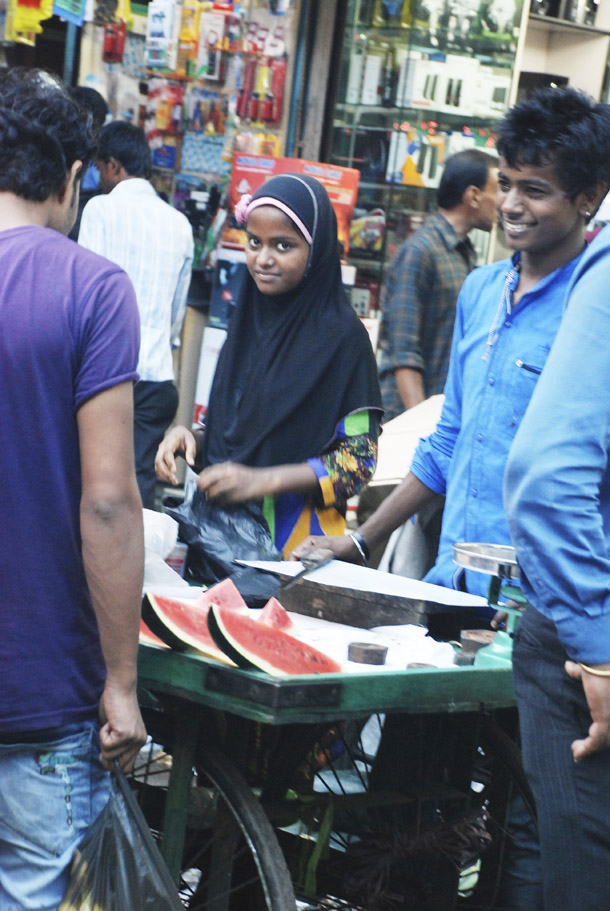
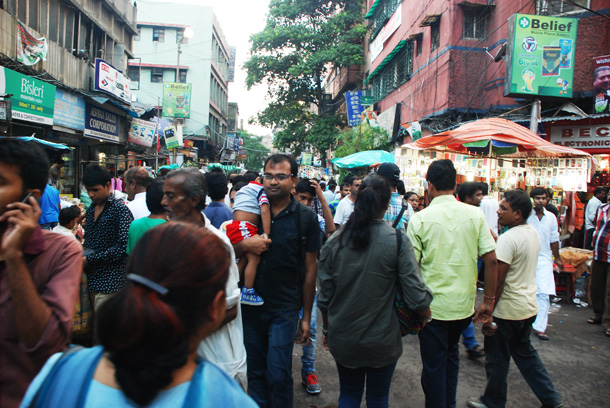
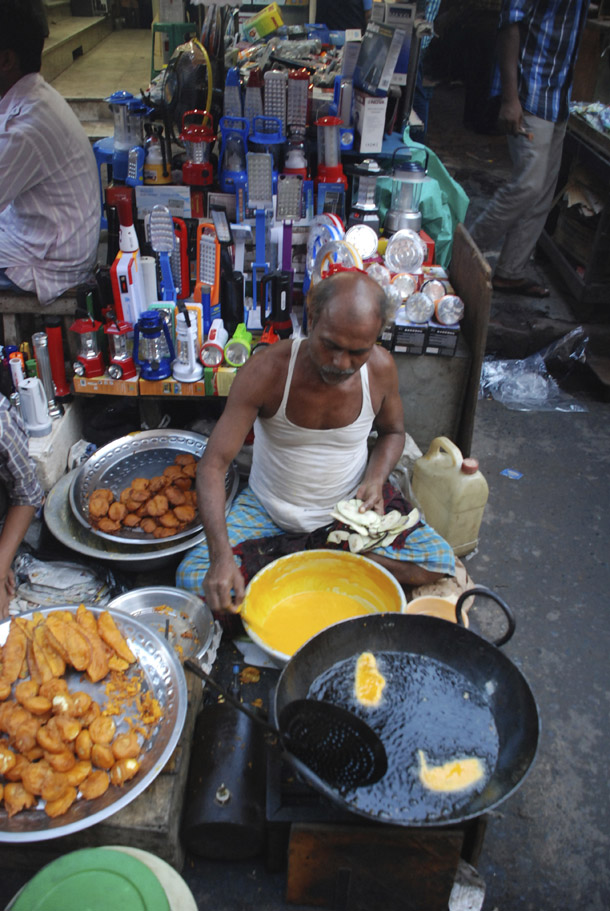
We walked through the Chandni Chowk market (above) and were greeted with food stalls which were preparing the fried Pakodas and other savouries for Iftar. There were assorted cut fruits laid out in plates, stalls selling dates, freshly squeezed lime and sugarcane juices. It struck me that excepting a few of us who were out that day to experience what authentic Iftar eats Kolkata had to offer, most around us were Muslims observing the fast. There was a sense of chirpiness around, a sense of urgency with the last minute preparations for Iftar. Every person walking past these stalls or assisting them, was immersed in the single purpose of Ramadan. The entire neighborhood was immersed in the act. The same sense of togetherness and involvement, the singleness of purpose that I had experienced a few years back when I had taken the Z-Sisters to Mallick Bazar around Park Circus area to experience Iftar by way of picking up Haleem and Firni. This is quite a contrary to the ostentatious Iftar Buffets in Dubai that I have got used to in the recent years.
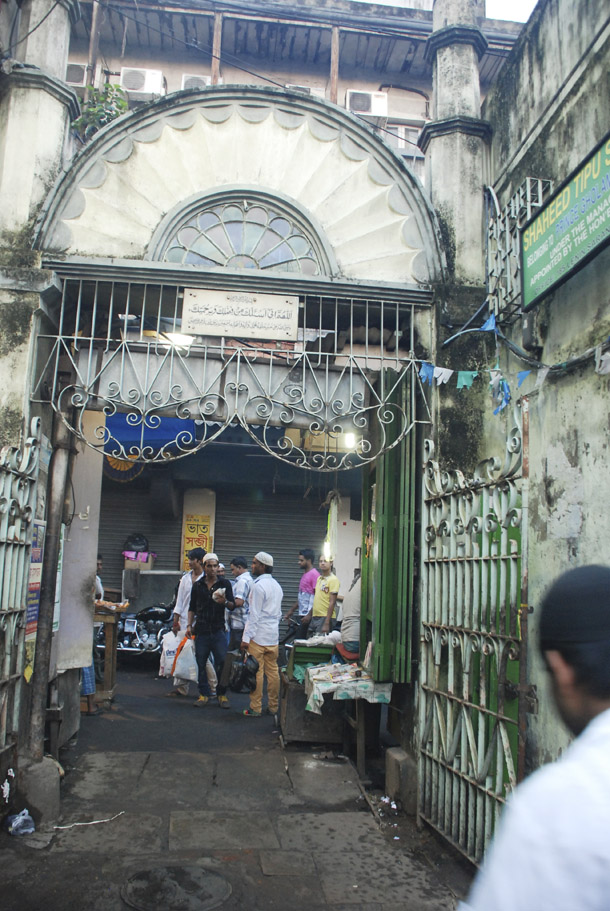
Rushing through Chandni Chowk and juggling through the crowd (Ifte informed us that this was hardly any crowd – the entire locality would actually get crowded post Iftar!), we reached the Tipu Sultan Shahi Mosque (above). Built in 1832 by Prince Ghulam Mohammed, the youngest son of Tipu Sultan – the ruler of Mysore, the mosque is an architectural heritage (it is said that the descendants of Tipu Sultan have been living in utter poverty in Kolkata although they are heirs to vast estates worth hundreds of millions of dollars). In many cases, similar stories of riches-to-rags story define many of the households in North Kolkata, where many of today’s shoriks or the property share holders are left with dwindling shares from a property which had once been worth millions.
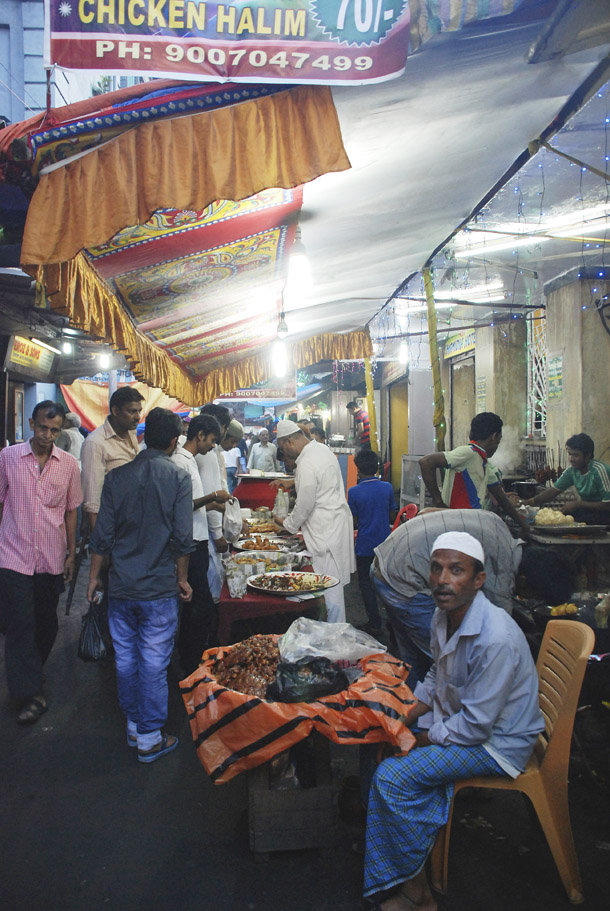
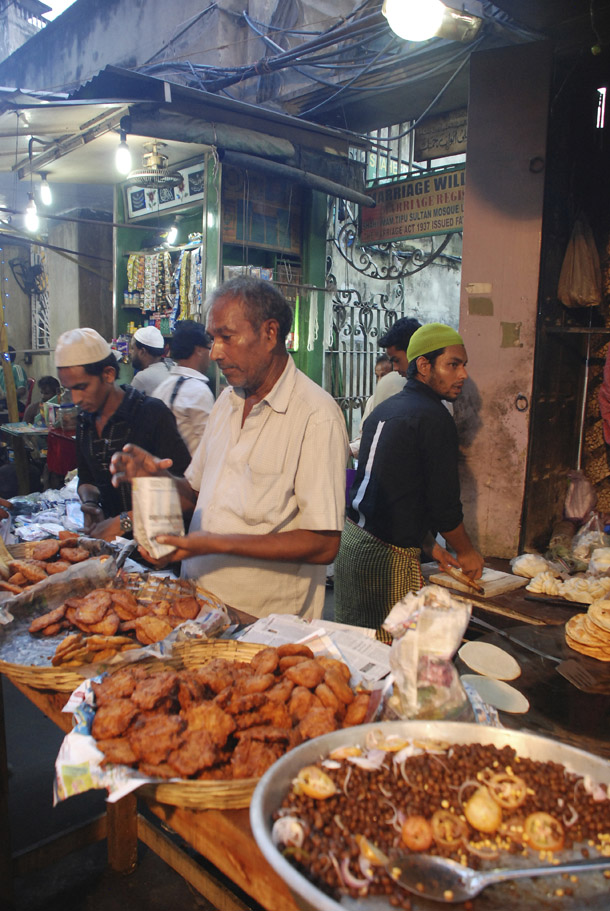
As darkness descended and people started to crowd the mosque area, we again pushed our way through the crowd, resisting the temptation to pick up some fried Pakodas on our way. As we reached a relatively empty spot where we made our first stop for food – yes, the Haleem. It wasn’t Iftar yet and Ifte who had been observing the fast hadn’t yet broken his fast. I was reluctant to eat anything as I gathered that almost everybody around us had been fasting throughout the day. But Ifte insisted that we try a bit of this Haleem – the Arbi Haleem (below), made with ‘not so great ingredients’ and ‘available all the year around’. This was the low-cost beef Haleem, found in most parts around many Muslim areas of the city like Park Circus, Colootola, Chitpur etc and cost only Rs 25/plate. The other members in our group weren’t keen to try the Beef Haleem and were offered Chicken Haleem. Halim or Haleem, is a special Ramadan dish made of wheat, barley, meat (usually beef or mutton, but sometimes chicken or minced meat), lentils and spices. This dish is slow cooked for seven to eight hours, which results in a paste-like consistency, blending the flavors of spices, meat, barley and wheat. Because of the difficult in cooking, Haleem is a delicacy and it is cooked in large quantities in a huge aluminum cooking pot, a feat that’s not often achievable at homes. There are still some restaurants which specialises in the special Haleem, cooked only during Ramadan – Ifte’s favourite being the one at Aminia, which we were about taste a bit later. We couldn’t finish our share of the Arbi Haleem and Ifte suggested that we give the left overs to one of the beggars who were there. As we showed reluctance to give away the left overs to a complete stranger, I felt this sense of guilt as if I wasn’t showering him with enough dignity… Ifte explained how eating from a shared platter formed an integral part of Islamic tradition… my head understood the logic, not my heart. Later, I read Ifte’s writeup in The Telegraph… everyone from the family comes together for the Iftar. Prayers are said and, traditionally, everyone sits on the floor. You are supposed to start with the dates, move on to the fruits, then the pakodis, dahi vada and sherbet but there’s no hard and fast rule. Not only does the family eat at the same time in the same house but we also share from the same plates.
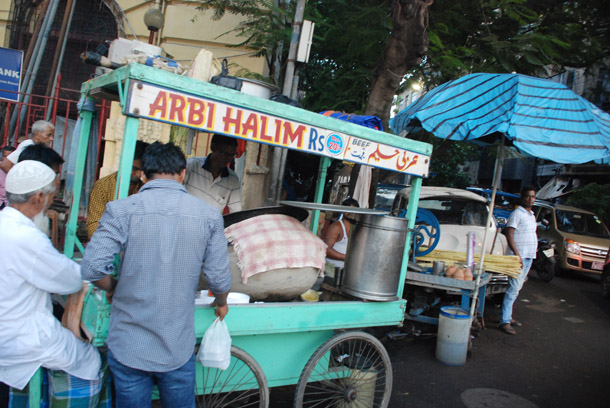
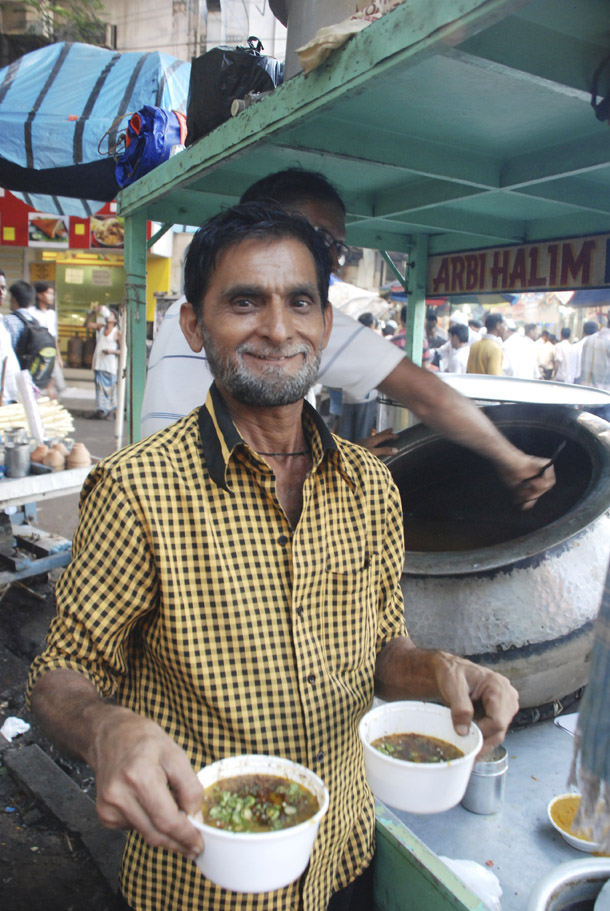

Post- Arbi Haleem, it was time to walk towards Zakaria street – a street that gets converted to a vibrant Ramadan bazaar with the kiosks selling Samaiya/Semolina, mixed fruits, Firni mix, glass bangles… much like the Mallick Bazaar experience that I had had earlier. Again we walked past many must-have-been-beautiful houses – filigreed grills, beautiful arches – all entangled in cable wires running from one end to another and falling out cemented blocks. We passed the red Bow Barracks (below) – a small pocket of Anglo-Indian population who have been living here for generations. Kolkata has been a conglomeration of many culture and still the city had pockets which distinctly held on to the their identities (and idiosyncrasies).
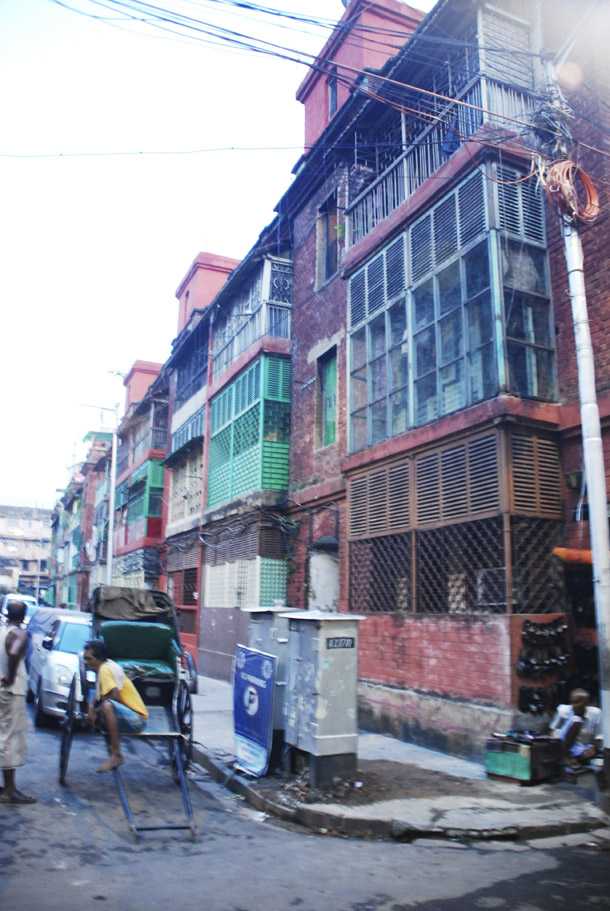

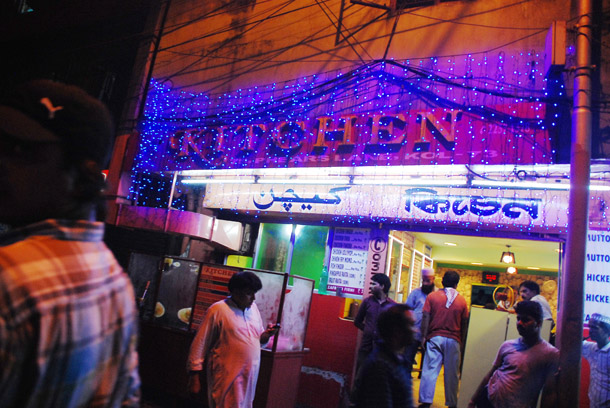
We came across many restaurants and sweet shops which had seen better times – some of them more than 100 years old. – for example, Haji Allauddin, which was popular for their pure ghee products. When we were in the Phears Lane, also known as the Chunna Galli, we heard the call to the Maghrib prayer (the evening call). Ifte broke his fast spontaneously with some Amriti (below).
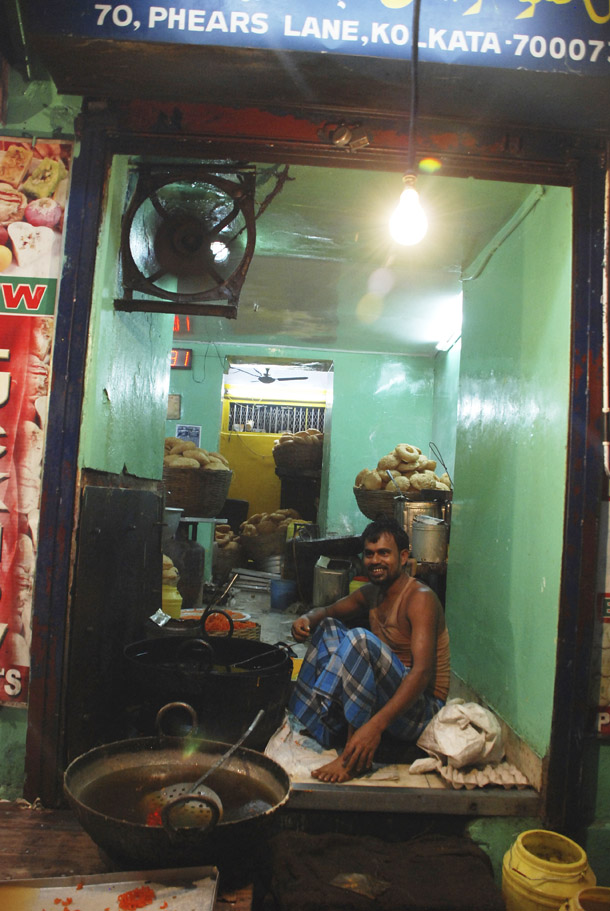

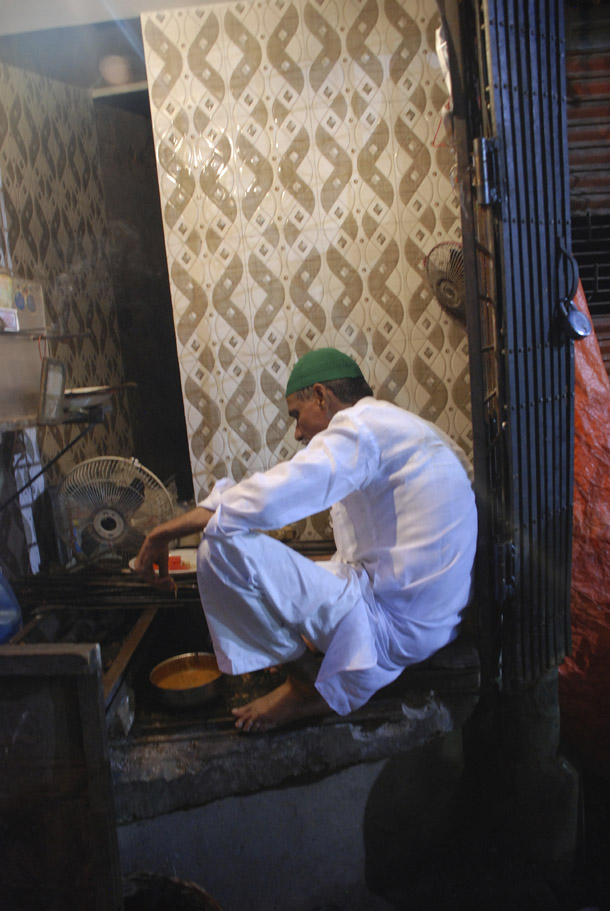
Zakaria Street was dazzling. People were breaking their fast together on dates – some of them complete strangers to each other. Ifte introduced us to a variety of dates and told us how different kinds of dates from the Islamic countries out poured in these markets during the Ramadan time. The cheapest ones came from Iraq and the most expensive ones came from Saudi Arabia. We tasted a few dates, I think they were the Iranian ones. Nobody took money from Ifte for the dates and we were indebted to these strangers for ever. Such is the essence of Ramadan. Decorated food stalls with marinated whole chicken and fish lurking through long hanging sheekhs beckoned us. Huge pots of Haleem stared back at us. But now our next stop would only be at the Aminia Hotel, where Ifte had called up previously and requested them to hold on to a few dishes of Haleem. The vendors at the stalls surrounding us were all busy taking in a few sips of liquid after a whole day of penance and abstinence… I caught a few solitary moments in my camera (much below) until we reached the Nakhoda Mosque.
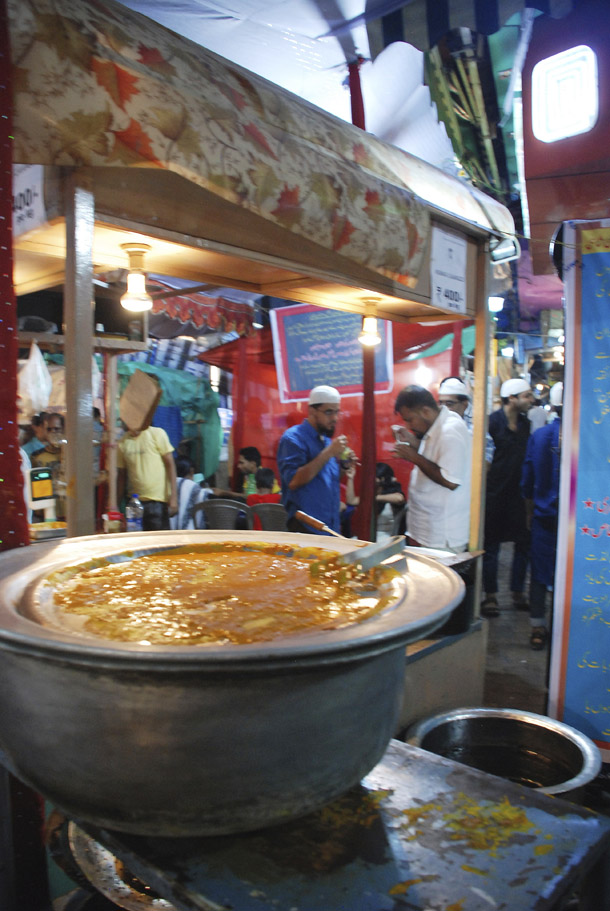
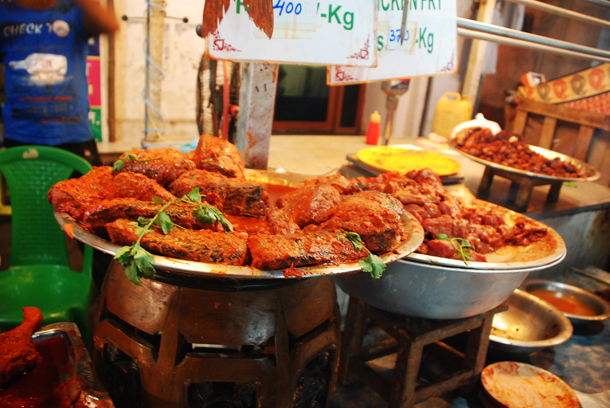
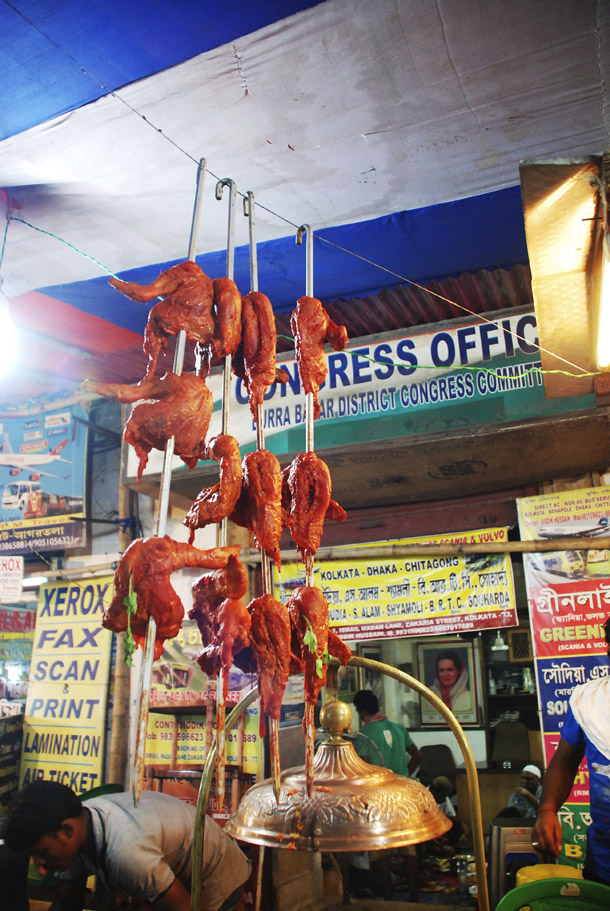

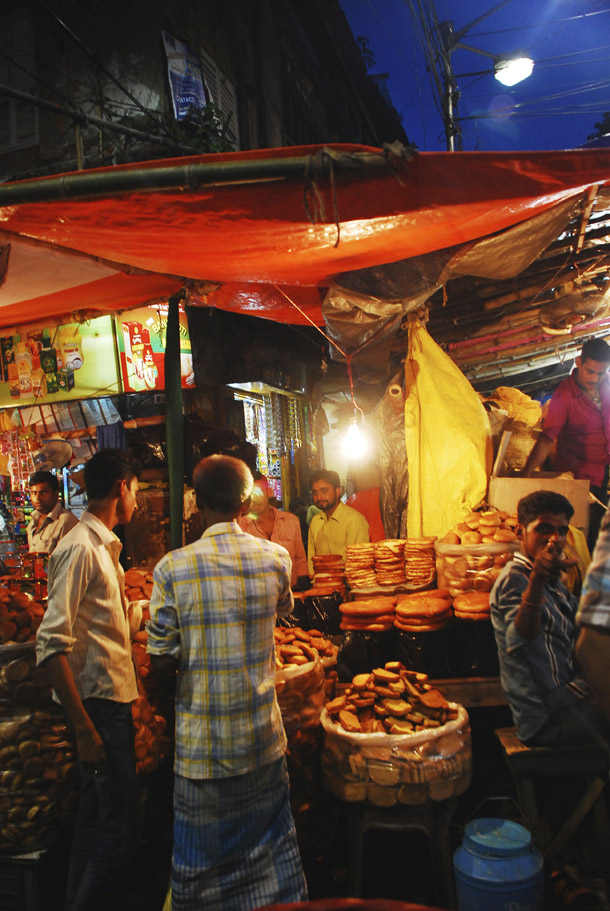
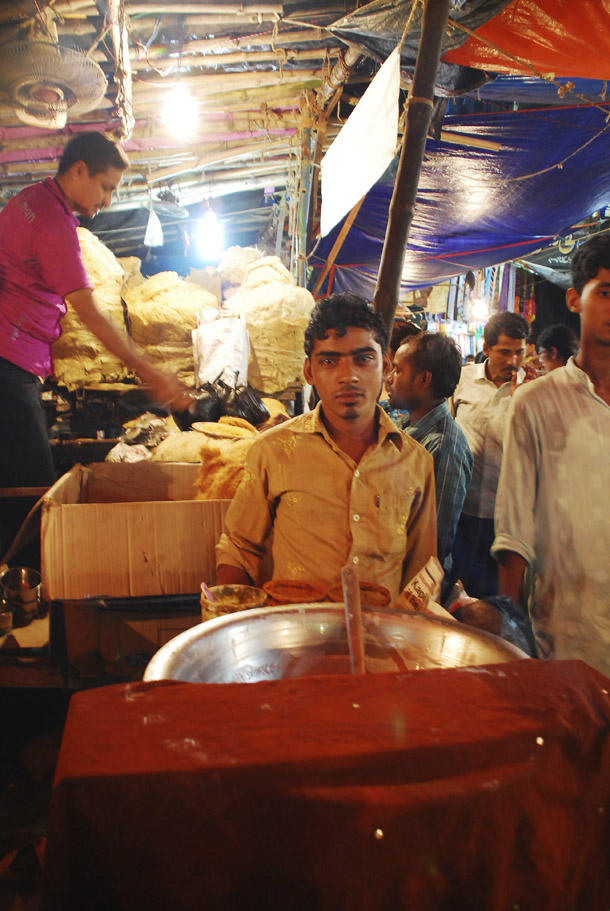
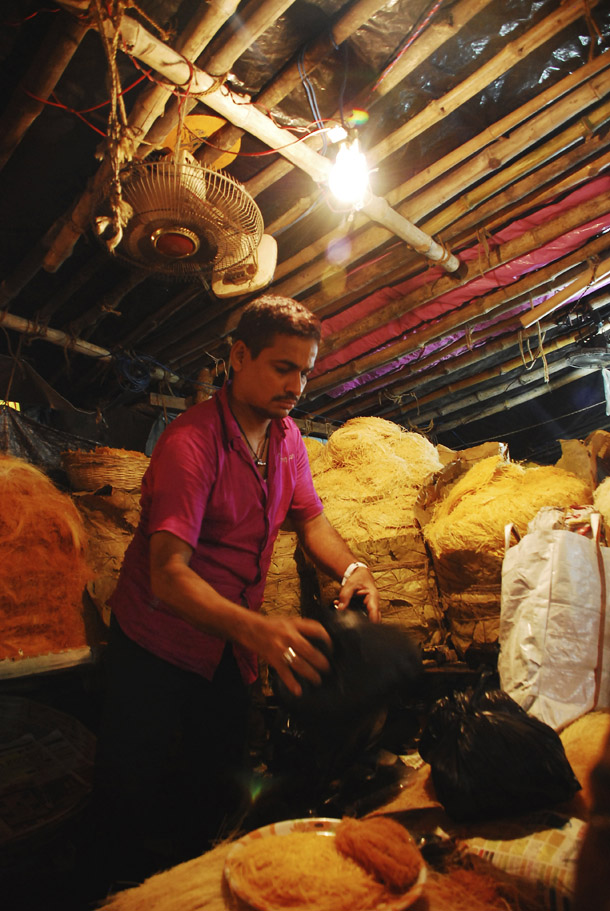
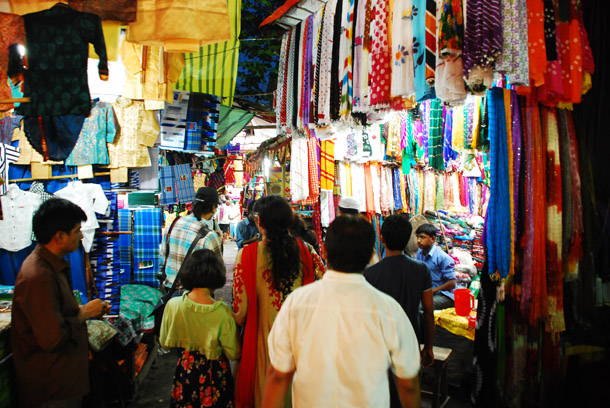
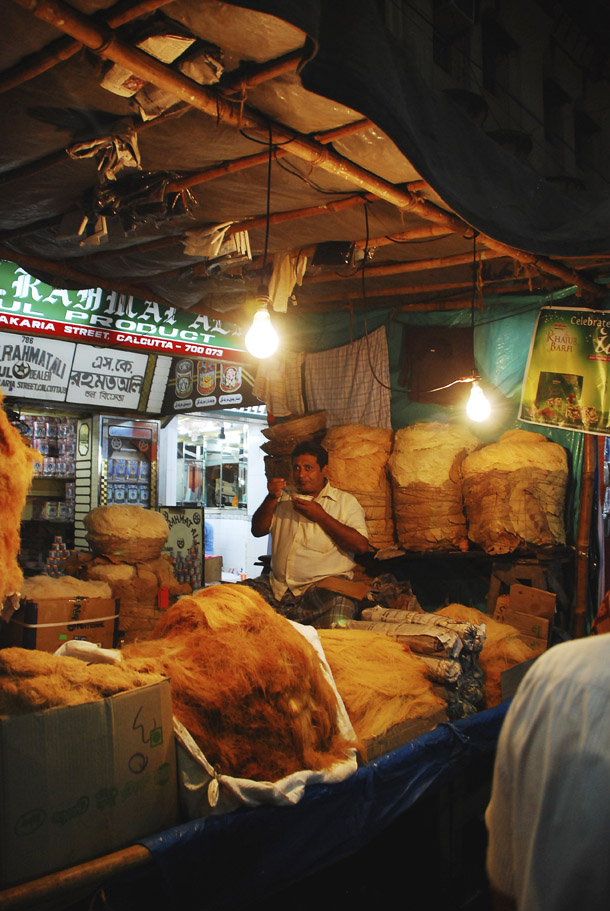

The Nakhoda Mosque (above) is the principal mosque in Kolkata, built as an imitation of the mausoleum of Mughal Emperor Akbar at Sikandra, Agra. People knelt down for prayers. Although we missed breaking Iftar in the mosque, the emotions weren’t missing. Although, I am not a religious fanatic or a ritualist having brought up by very liberal Hindu parents, I love the way religion brings people together (and am also pained by how religion separates us) and I am mersmerised by the enigma of varied cultural/religious aspects of different places (like in the Pashupatinath temple in Nepal). Although, I have refrained from expressing my personal opinion on politics and religion in my writings that might reflect any bias or hurt any religious/cultural/spiritual sentiment, I have grown up in the multicultural Kolkata where we have participated in all festivals from all religion (I have wriiten about it here and here). The strong beliefs and faiths reinforcing the expression on the faces of devotees during worship, the colours, the rituals, the stories underlying these rituals – these fascinate me and I felt blessed to have been able to immerse myself in the crowded Ramadan bazaar that evening. And finally we reached Aminia, just infront of the Nakhoda Mosque gate.
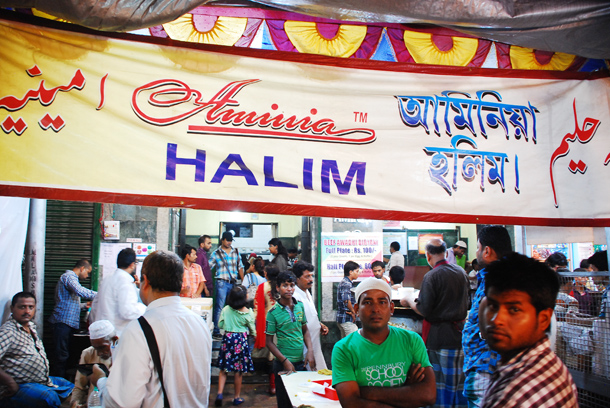
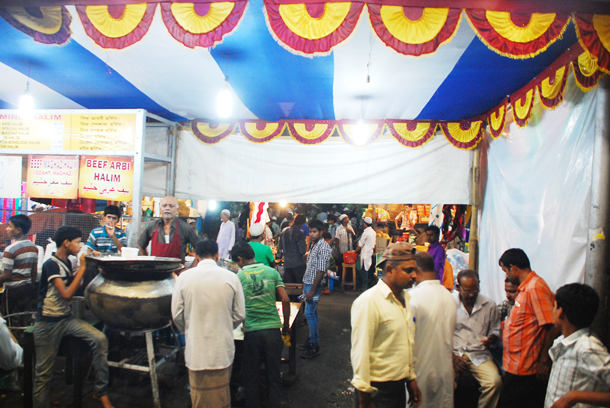
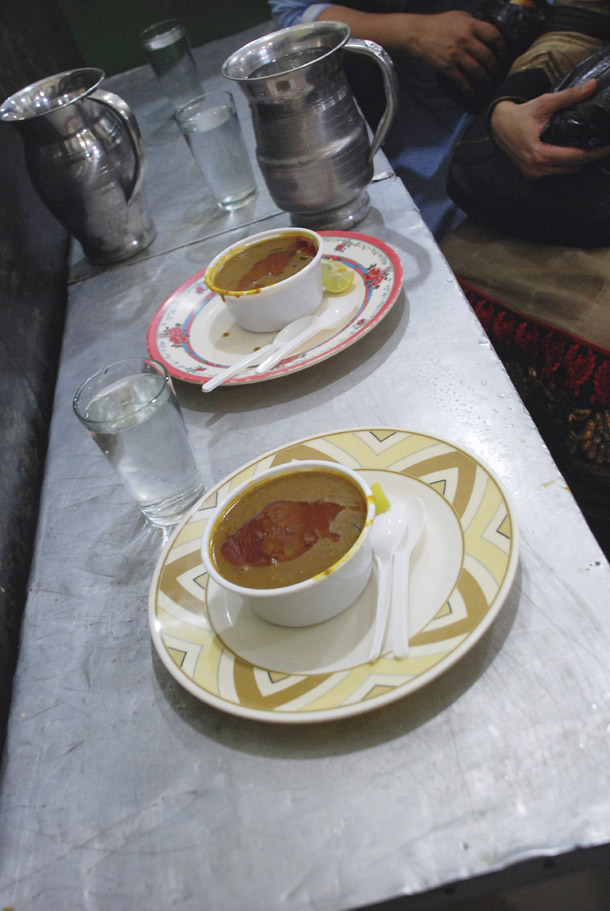

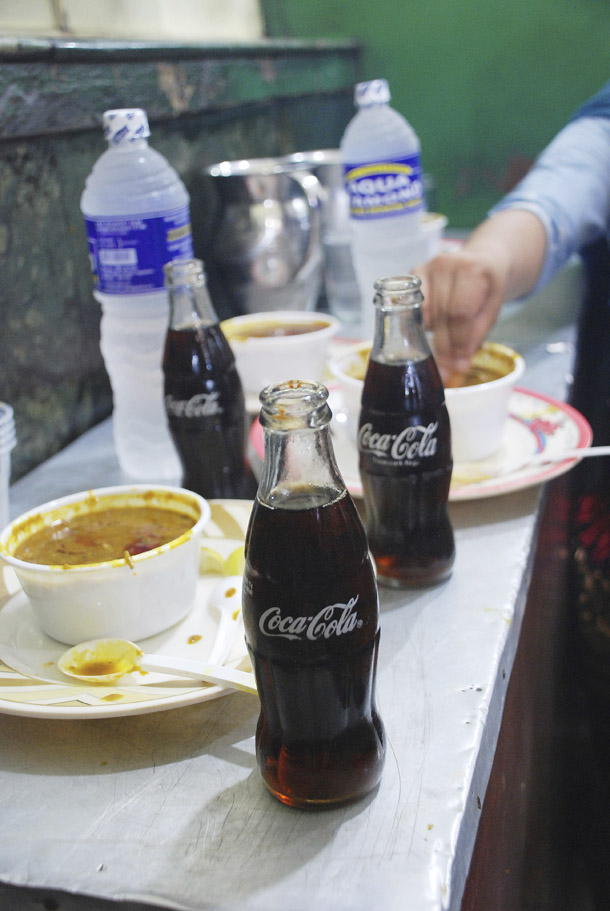
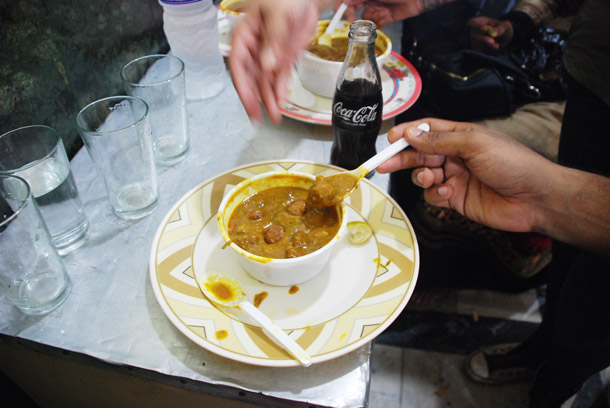


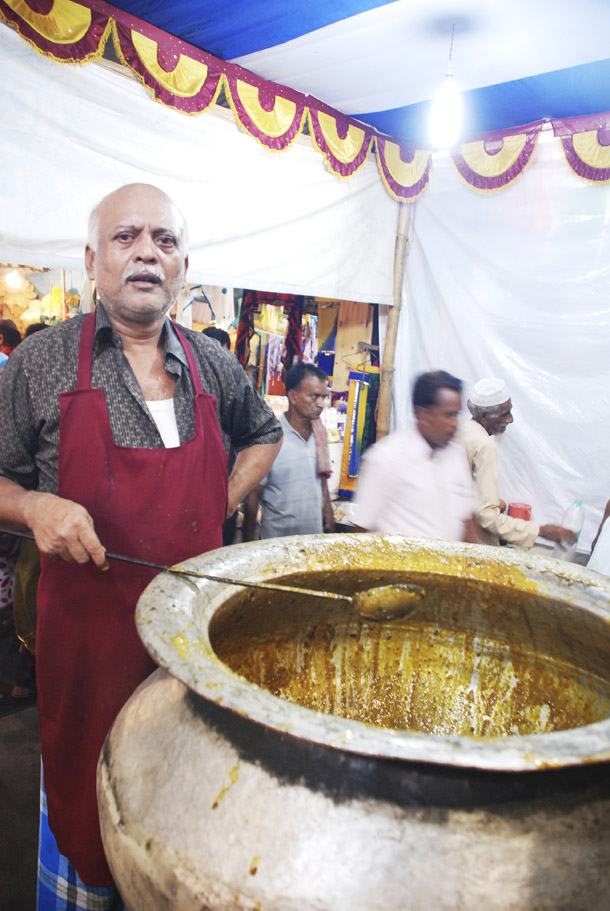
This was the original Aminia Restaurant established in 1939. The Haleem here is a brand name. people queued in front of the make shift Shamiana for the Haleem. Here, the Haleem practically disappears. The restaurant starts selling Haleem from 2 pm and by the time, it’s Iftar, nothing is left of it. A man serving out from a huge pot just outside the restaurant holds centre stage. We went inside looking for a table and some chairs. A makeshift table was created – it looked like a low box with an aluminum lid. Rapid cleaning off the surface with a over used cloth, and our table was ready. A variety of Haleems are served here – the Chicken Regular, Chicken Boneless, Mutton, Beef Arbi and Beef Special (with tongue and brains!) – all varying from Rs 95 – Rs 155/plate. 2 plates of Mutton and Beef Haleem arrived at the table. We dipped our bread pieced into the thick creamy gravy, piercing into the thin floating layer of oil or the Rogan. Ifte explained how this Rogan was poured onto the the top separately and the more the Rogan the better it tasted. I asked for a ThumsUp – the strong fizzy Indian cola to cool down the heat, but was offered Coca Cola instead. As we were about to finish our Haleem, the staff came and gave us a few chicken meat balls (as a compensation for not being able to serve Chicken Haleem which had already got over)… they dunk themselves happily into the remaining Haleem gravy. I went into the large kitchen to take a few photographs (I love entering restaurant kitchens) with one of the cooks obliging blissfully as he posed. ‘How many people do you cook for daily?’ He hesitated before replying – ‘1000. No, I think more!’
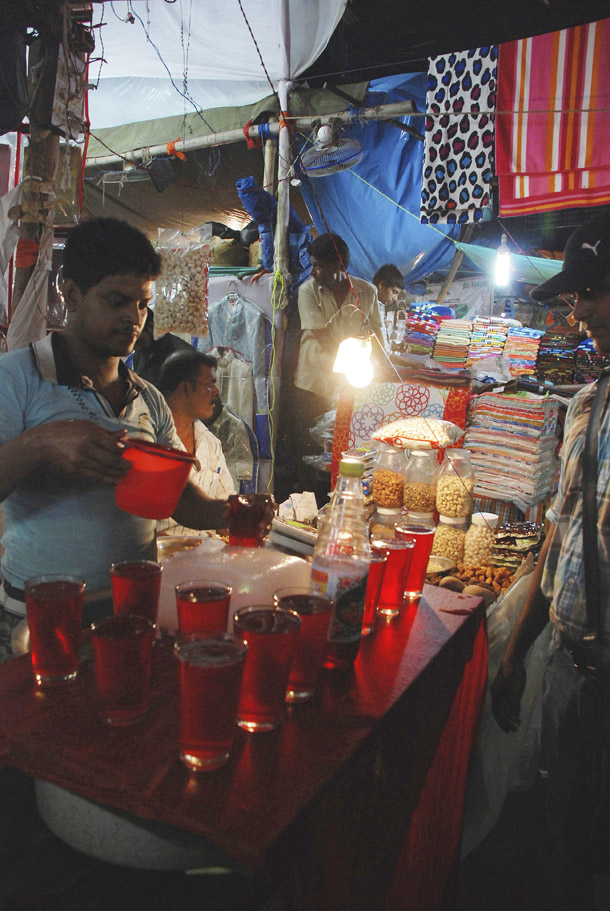
Before we merged ourselves into the cacophony of the Chitpur road, there is another surviving tale that I have to recount – the Roohafza episode. Bright voluptuous red drinks that Ifte insisted that we must try. Well, not a Roohafza fan at all, I hesitated. These drinks have always looked suspicious to me. More so because of the water in which the famous Hamdard Roohafza was diluted in. Even before I embarked on my journey of being the notoriously-stressed-out-always-suspiscious-about-water-from-the-streets, I have never drank these coloured drinks sold by the vendors by the roadside – how ever bright and tempting and refreshing they looked! Now many hours past the episode, I have survived to tell the tale and I can only say one thing – belief and faith is what cleans the germs. Specially, if you had frowned upon the plastic mug that had been used for mixing the drink!
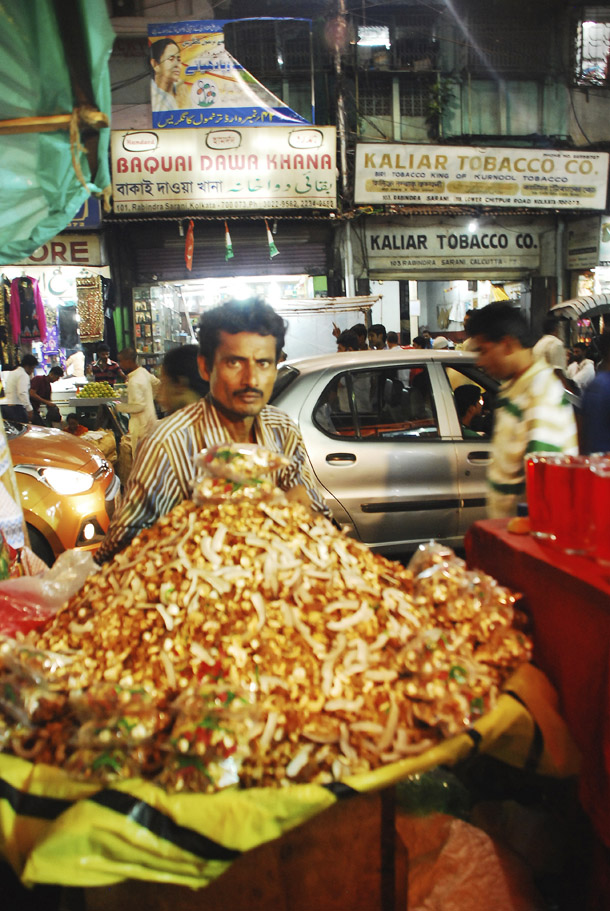
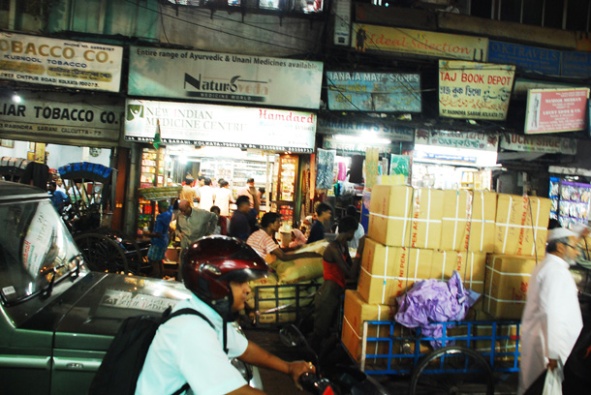
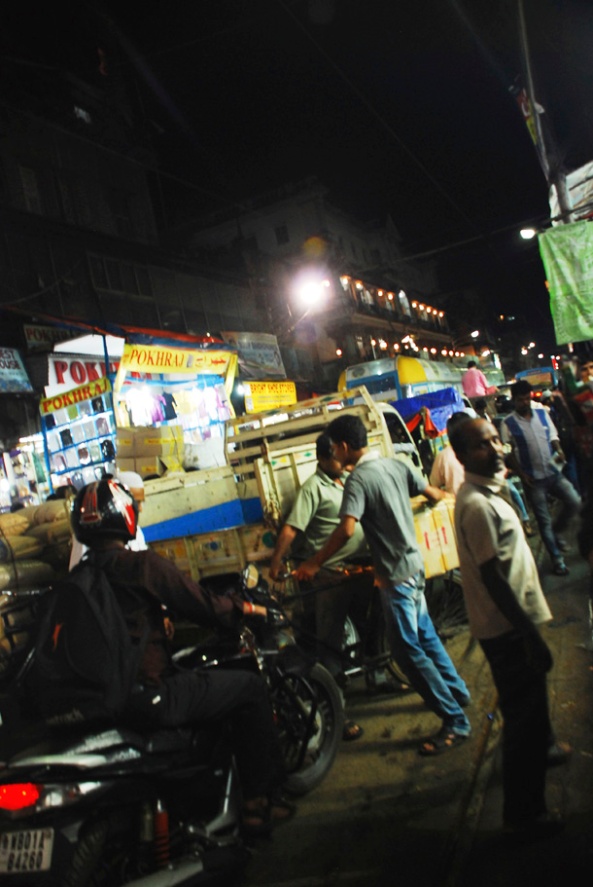

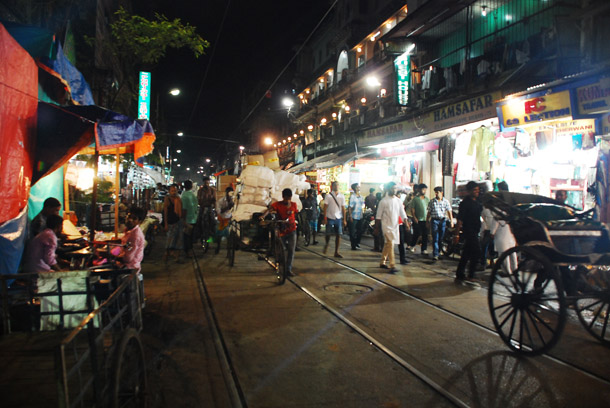
Drama, noise, a little bit of roller coaster walk on foot and this was Chitpur Road or today’s Rabindra Sarani (above) – the route that would lead us to the best Mutton Biryani and Mutton chaap that Kolkata has to offer – Royaler Biryani. Before reaching the Royal Indian Hotel, my million dollar question to a Kolkata outsider would be – what would make walking along the Chitpur road easier for you? Would an astronomer suit help? Tram, buses, cars, rickshaws and pedestrians – all juggling and jostling for some decent space – this is an incredible experience. Lined by buildings dating back to centuries, this is a sensory overstimulation. We were welcomed at the Royal by the aroma of the Mutton Chaap wafting through the window that graced the entrance. A lungi-clad man held onto the ladle with such an expertise and overdose of confidence that could only come with years of experience and the title that they served the best Mutton Chaap in town. We walked up the stairs to the modernised air conditioned cabin and as the realisation of the distance that we had actually managed to cover in the last few hours seeped in, I felt exhausted. It was time to sit down and gorge on some high-carb diet of Mutton Biryani. The best Mutton Biryani, the Mutton chap, a few selfies and Facebook worthy pictures clicked by the Royal staff and a gorgeous piece of Shahi Tukda later… Ifte introduced me to the Gulam Nabi, the head chef of Royal, a descendent of the direct lineage of the khansama of Wajid Ali Shah. How did I like the Royal Biryani? For me, a Kolkata Biryani without the legendary aloo and deem / potato and egg, is an incomplete dish. A huge slap on my face for I have been screaming so hard about how important and essential the aloo is in our Biryani. Apparently, aloo and deem came to substitute for the meat in the Biryani in times of hardships – so it is the sort of the poor man’s Biryani! As Ifte tweeted later to my lament on no-aloo Biryani… ‘Royal would die out rather than introduce aloo and deem in their Biryani. Total no no.’
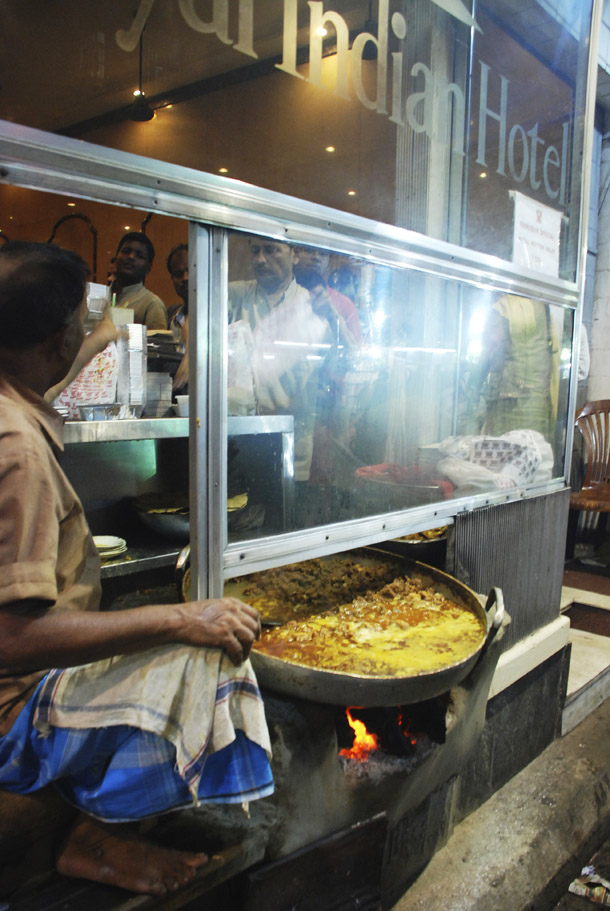
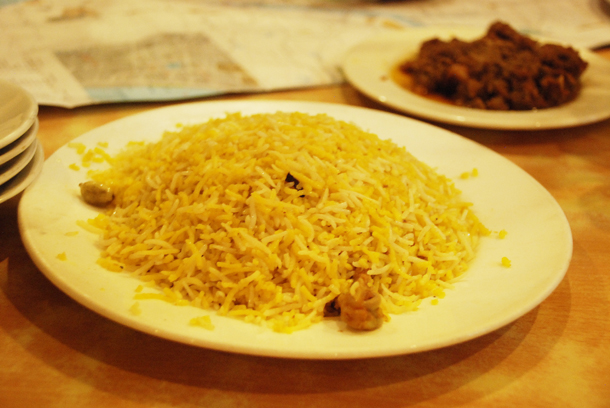
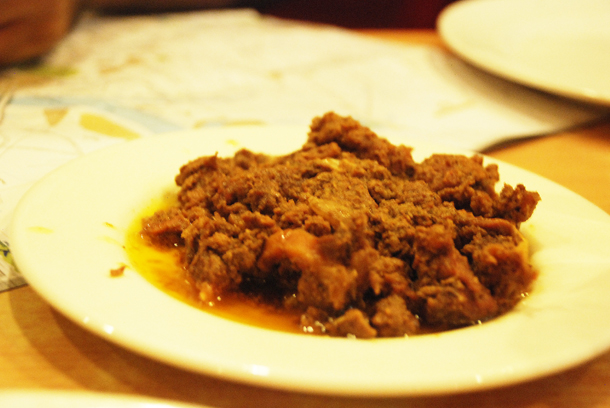
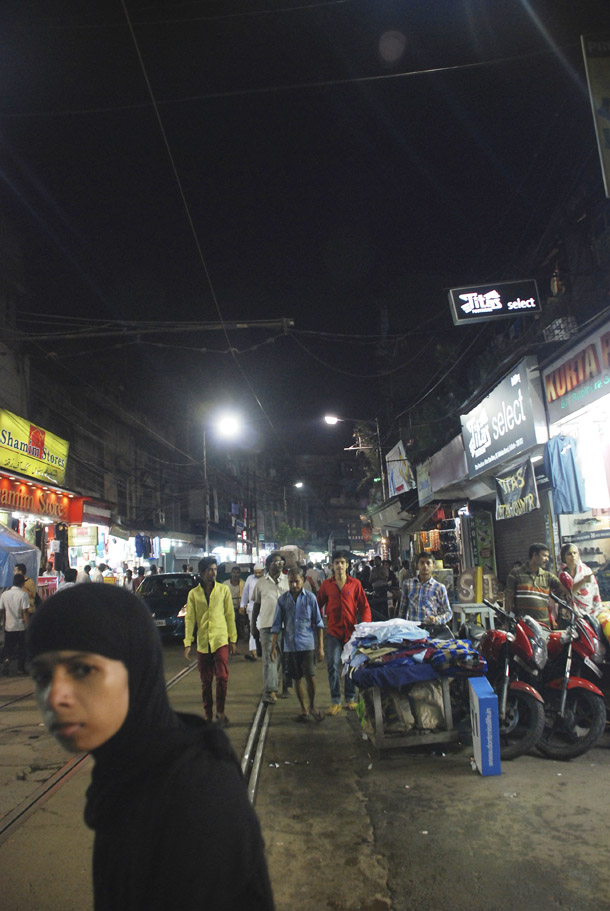
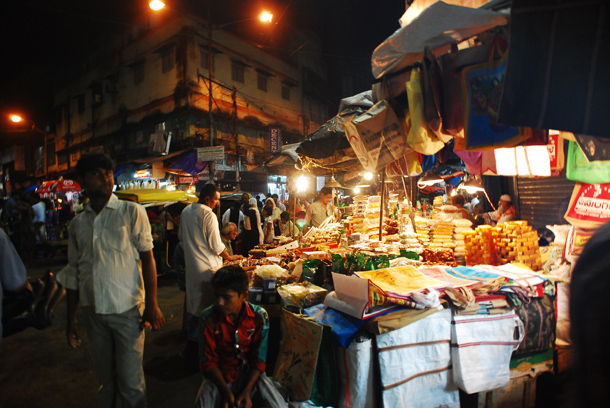
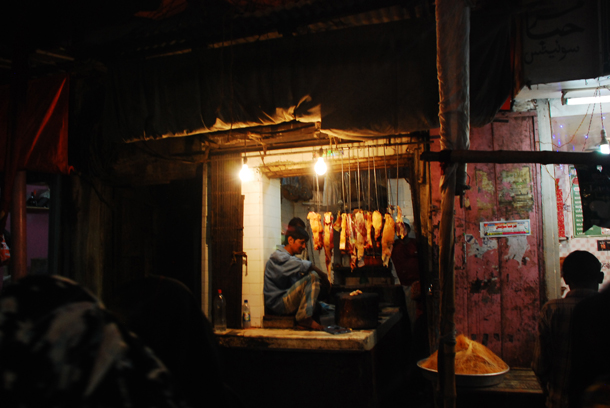

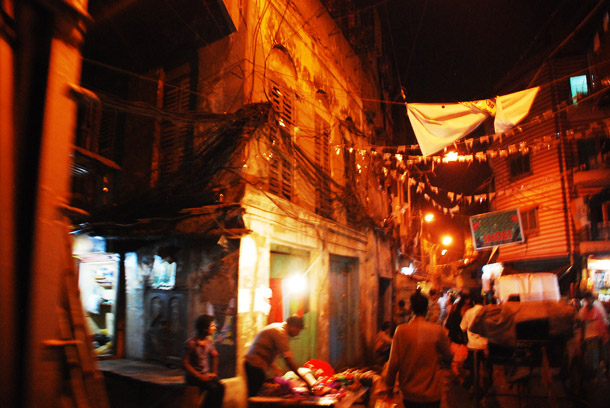
After Royal, we had to go back the same way – walking along the Chitpur Road, zigzagging through Zakaria Street, Phears Lane, Chandni Chowk… now I simply wanted to go back home. 4 hours of walking through Kolkata is not really the kind of food walk that I had done in Dubai earlier… Kolkata is not like any other city… the roads are not even, the tram lines jut through like speed breakers, the occasional potholes falter your foot steps. But this is where strangers share dates with you for free. Oh and that reminds me that at Aminia too, they refused to take money from Ifte. This is a different world altogether – an emotional roller coaster, an epic kaleidoscope. The evening had been really memorable – I came home with bitter blisters but an extremely happy soul. May you all have a blessed life… specially those living in all the conflicted areas in the same world that I just walked upon a few minutes back – eating, clicking and feeling blissfully happy!
Unblogging it all… Ishita
Disclaimer: A tour with Calcutta Walks cost INR 1500 – 3000/person, depending upon the tour. Although I had booked into the tour, Calcutta Walks generously hosted me. Please note that this post is not a sponsored post and the subject, story, opinions and views stated here are my own and are independent. While you enjoy reading the posts with lot of visuals, please do not use any material from this post. You can catch my daily food and travel journey on Instagram, Facebook and Twitter.
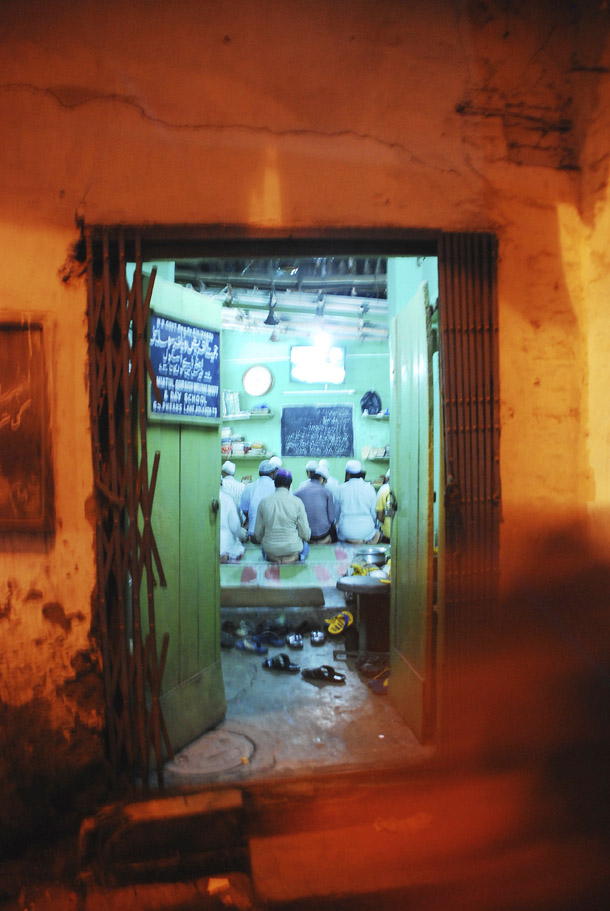
Related Articles:
Save












i missed capturing the Eid Namaz at nakhoda Masjid . this is one photowalk i will definietely take up next time
LikeLike
It was definitely an experience. Your Flikr photos capture the moments splendidly too:)
LikeLike
Pingback: The Legend of Flurys Still Continues in Park Street |
Loved it, thanks for the share Yummraj
LikeLike
I’m so hungry now! Kolkata sounds a fascinating, exciting city and I’d really love to visit one.
LikeLike
Thank you Kat for hopping in and showering compliments on the city that I have grown up in!
LikeLike
It was wonderful to read and see pictures… The streets and People looks more beautiful than before.Good work, Being a native thanks.
Regards
Md.Ikhlas
LikeLike
Thank you for the lovely compliment:)
LikeLike
A very fascinating and atmospheric post Ishita. Thank you for sharing.
LikeLike
Thanks Madhu… would definitely suggest that you book yourself for Ifte’s Calcutta Walks tours… he’s got too many interesting ones to choose from.
LikeLike
Reblogged this on maverickbird and commented:
Some food thoughts from my fellow Calcuttans
LikeLike
Pingback: Abhijaan 2015 – Bengali Film Festival In Dubai | Teenkahon – Three Obsessions | IshitaUnblogged
Pingback: Abhijaan 2015 – Bengali Film Festival In Dubai | Manoj Michigan’s 89 | IshitaUnblogged
Pingback: Abhijaan 2015 – Bengali Film Festival In Dubai | Arindam Sil’s Ebar Shobor | IshitaUnblogged
Pingback: Abhijaan 2015 – Bengali Film Festival In Dubai | Anindyo Ghosh’s Bharaate | IshitaUnblogged
Pingback: Abhijaan 2015 – Bengali Film Festival In Dubai | Atanu Ghosh’s ‘Ek Phali Rodh’ | IshitaUnblogged
Pingback: Where Will You Eat Bengali Food In Kolkata? | From Traditional to Bohemian | IshitaUnblogged
Pingback: Shubho Bijoya to all | Immersing in the bonding of love
Lovely read. I am guessing that the haleem was a bit more runny than the hyderabad one. Ironically, Royal is said to have added alu in their new outlet at Park Circus
LikeLike
Thank you Kalyan! Even I re-read the old article and felt how come I don’t write like this anymore. Oh no, Royal should have retained their stance – that’s what makes it unique and that’s what gives us a chance to debate! Have you been to any of Iftikhar’s Walks? I have done three so far, and its amazing how much there is to learn about the city that I felt I knew a lot about. Love 🙂
LikeLike
Pingback: What we ate in Lucknow – and still dreaming of – IshitaUnblogged